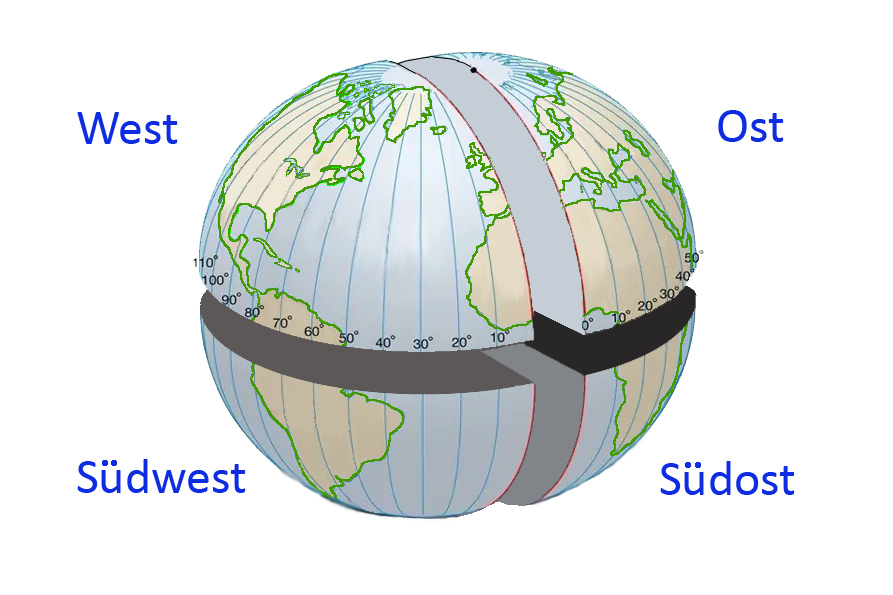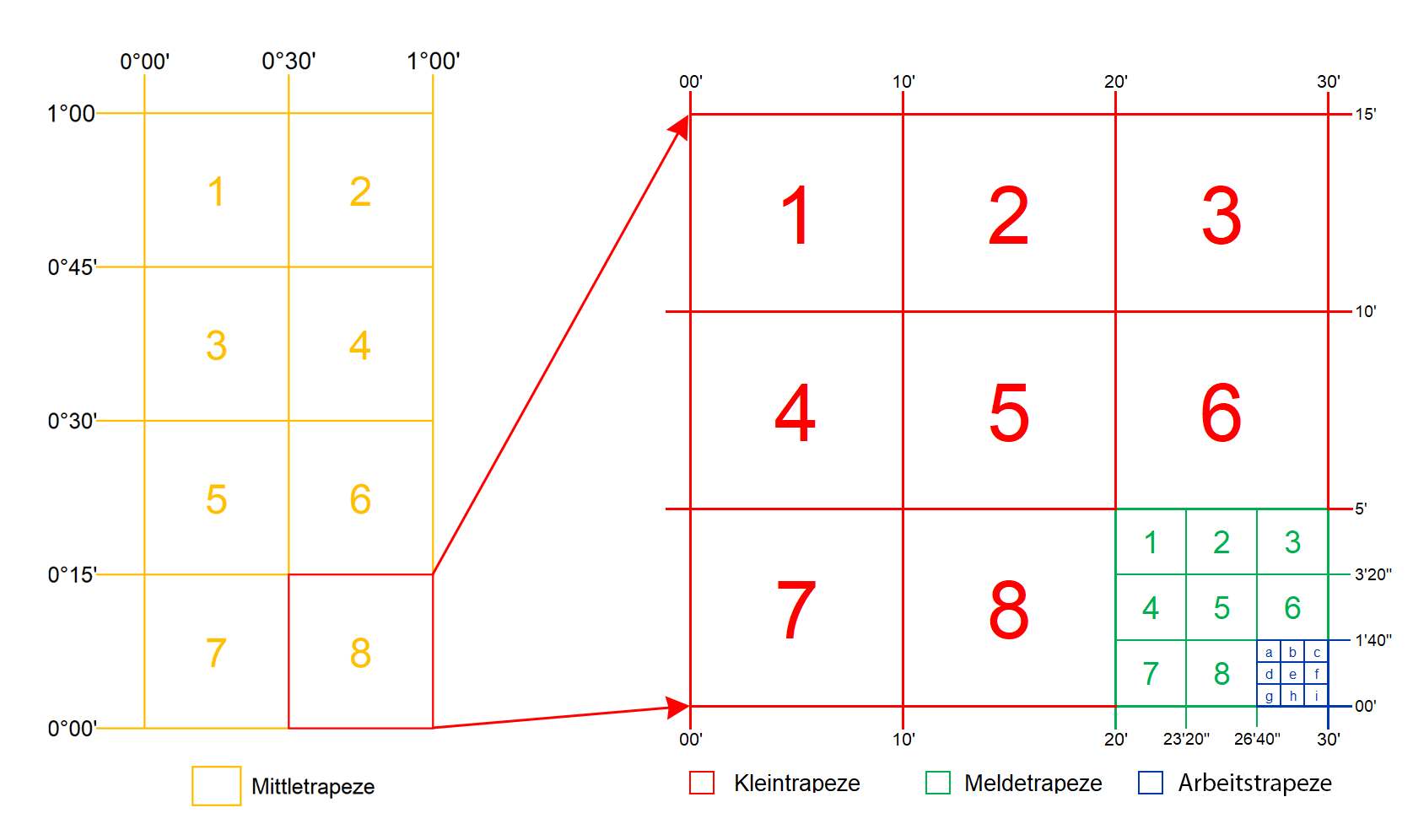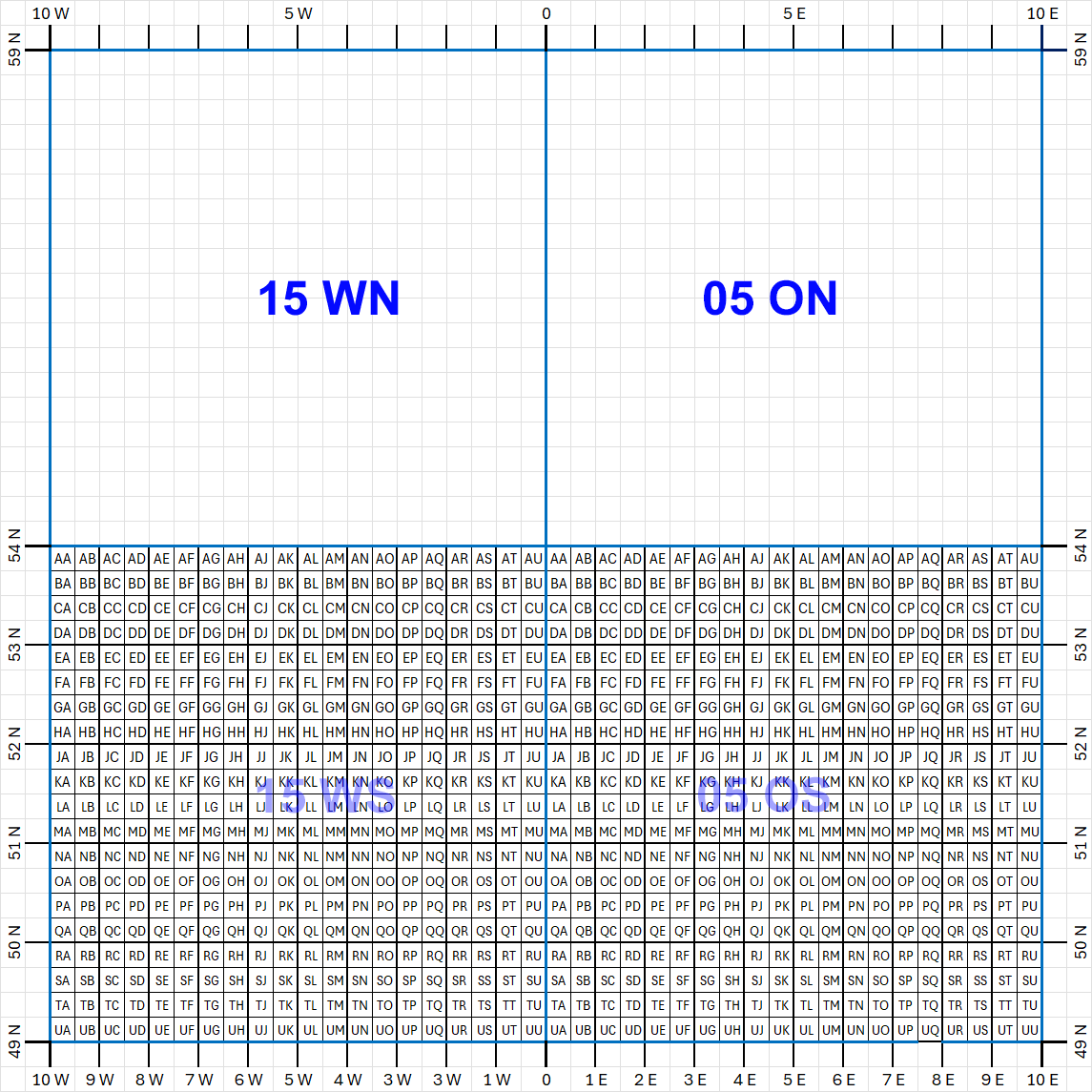25/26th May 1943




At the start of WWII, the Luftwaffe was using the map reference system Gradnetz or Grid Network, also known as Gradnetzmeldeverfharen (GNMV) or Grid Network Reporting Method, where the map of the world was broken down into quadrants, and then further subdivided into ever smaller units measured in degrees, minutes and seconds of latitude and longitude.
This reporting network was already in use by the Luftwaffe before the war and was maintained almost unchanged until the end of April 1943. The system was refined from 1st May 1943, with the introduction of more subdivisions of the smaller units and also by the introduction of a new network, the Jagermeldenetz (JMN) or Fighter Reporting Network, to assist fighter aircraft and anti-aircraft units against the increasingly effective Allied bombing campaigns.
To further complicate matters, the Wermacht and Kriegsmarine used their own independent Gradnetzmeldeverfahren which were not compatible with the Luftwaffe's.
Gradnetzmeldeverfharen (GNMV)
The Gradnetzmeldeverfahren Grid Network Reporting method divided the world into four quadrants with the main divisions made from the 0° meridian (Greenwich) and 1° southern latitude. Each quadrant had longitudinal divisons every 10° of longitude towards the east and west by the 10°, 20°, 30°, 40°, etc. lines of longitude, and latitudinal divisions every 10° from north to south by the 89°, 79°, 69°, 59°, 49°, etc. degrees of latitude. The trapezoidal boxes created by the 10° x 10° lines of latitude and longitude are called Zusatzzahlgebiete (ZZG) (Supplementary Number Areas).
Zusatzzahlgebiete (ZZG) (Supplementary Number Areas)
Each Zusatzzahlgebiete is therefore defined by an area within ten consecutive degrees of latitude and longitude, with the starting latitude being 1° south (-1 degree south of the equator), from where it goes in steps 10° north or south. The starting meridian is the zero meridian of Greenwich, from where it goes in steps 10° east or west. The Zusatzzahl number is determined by the tens digit of the longitude and latitude of the top left (northwest corner) of the Zusatzzahlgebiete area. The first number denotes the tens digit of the longitude, the second number denotes the tens digit of the latitude. For numbers under 10 degrees, a zero is added. For example, a Zusatzzahlgebiete that runs from 00°longitude 59°N latitude in the NW corner to 10° longitude, 49°N latitude in the SE corner would be designated '05'. For numbers over 90 degrees of longitude, the first two numbers are used, e.g. a Zusatzzahlgebiete that runs from 120° W longitude 49°N latitude in the NW corner to 110° W longitude, 39°N latitude in the SE corner would be designated '124'

Because the ZZG could be in any one of the four quadrants, the following descriptions were added to the number : ''Ost' to the east of the prime meridian and 'West' to the west of the prime meridian in the Northern Hemisphere (above 1° S), 'Südost' to the east of the prime meridian and 'Südwest' to the west of the prime meridian in the Southern Hemisphere (below 1° S).
In the first example above therefore, the ZZG would be designated 05 OST, and the second 124 WEST.
Großtrapez (Large trapezoid)
The subdivision of the Zusatzzahlgebiet is based on whole longitudes and latitudes i.e. 1° squares. The area limited by two consecutive longitudes and latitudes is called a Großtrapez (Large trapezoid). There are therefore 100 Großtrapeze in a Zusatzzahlgebiete, numbered from 00 to 99.
The numbering system works in a similar way to the ZZG, but by taking the last digit of the longitude and last digit of the latitude in the upper left corner of the Großtrapez as shown in the examples below:

The size of a Großtrapez is about 70 x 111 km at the latitudes covered in this website. The further from the equator, the more trapezoidal the Großtrapeze become, as the longitude lines converge towards the poles.
Mitteltrapez (Medium Trapezoid)
The first division of the Großtrapez is into eight Mitteltrapeze (Medium Trapezoids sized 15' x 30') by the parallel lines of 15', 30', and 45' and the meridian line of 30'. The numbering of the Mitteltrapez occurs line by line from the top left to bottom right, starting with '1' through to '8'.
Kleintrapez (Small Trapezoid)
The second subdivision is into nine Kleintrapeze (Small Trapezoids sized 05' x 10') by the parallels of latitude spaced 5' apart and the meridians spaced 10' apart. The Kleintrapeze are labelled with the numbers 1 to 9, starting in the upper left corner down to the lower right corner.
Meldetrapez (Reporting Trapezoid)
The third subdivision is into nine Meldetrapeze (Reporting Trapezoids sized 1'40" x 3'20") by the parallels of latitude of 1'40" and 3'20" (etc) and the longitudinal meridians of 3'20" and 6'40" labelled with the numbers 1 to 9, starting in the upper left corner down to the lower right corner. This subdivision is usually sufficient for reporting accuracy, being about 3 x 4km in size. According to the old Gradnetzmeldeverfahren reporting procedure (valid until April 30, 1943), the classification was done in only four Meldetrapeze with the numbers from 1 to 4.
Arbeitstrapez (Work Trapezoid)
The fourth subdivision is into nine Arbeitstrapeze (Work Trapezoids sized 0'33.33" x 1'06.67") by the parallels of latitude 0'33.33" and 1'06.67" (etc) and the longitudinal meridians 1'06.67" and 2'13.34" in the Meldetrapez. The labels run from ‘a’ to ‘i’ starting in the upper left corner down to the right lower corner. This smallest subdivison covers an area of about 1 x 1.2 km. In the pre-May 1943 system, there were only 4 Arbeitstrapeze named ‘links oben’ (lo - top left) rechts oben (ro - top right) links unten (lu - bottom left) and rechts unten (ru bottom right).

Jägermeldenetz (JMN)
The Jägermeldenetz (Hunter/Fighter Reporting Network) was a separate mapping system to the Gradnetzmeldeverfharen (GNMV)
for the guidance of fighter aircraft, anti-aircraft artillery and early warning systems.
In the Jägermeldenetz system, the Zusatzzahlgebiete were divided into a northern and a southern part, called Jagdtrapeze. For example, '05 Ost' would be subdivided into '05 Ost Nord' and '05 Ost Süd'. The term Großtrapez was dropped, and instead each Jagdaptrapez (sized 5° x 10°) contained 400 Mitteltrapez, designated by two upper case letters. Starting in the northwestern corner running in rows from west to east and north to south, the descriptions started with ’AA’, ’AB’, ’AC’ and so on until ’AU’, then ’BA’, ’BB’ all the way through to ’UU’. The letter ’I’ was not used to avoid confusion with the letter J.

Within the Mitteltrapez, the Kleintrapez, Meldetrapez and Arbeitstrapez remained unchanged.
The Reichstag building in Berlin is situated at 52.518720 N 13.3762568 E
Under the Gradnetzmeldeverfahren (post May 1943) system this would be shown as:
ZZG |
E/W |
Gross |
Mittel |
Klein |
Melde
Arbeit | |
15 |
Ost |
33 |
3 |
9 |
7 |
c |
Under the Jägermeldenetz system this would be shown as:
ZZG |
E/W |
Jagd |
Mittel |
Klein |
Melde
Arbeit | |
15 |
Ost |
Süd |
FG |
9 |
7 |
c |
Planquadrat
A Planquadrat or Grid Square, was the description of a location using one of the above mapping systems. For example, the Planquadrat for the above example is 15 O 33 3 9 7 c for the GNMV system or 15 OS FG 3 9 7 c for the JMN system. Locations provided by the Germans tended to omit the ZZG number, presumably because it was expected that the reader would already know the general location, and give only the Grosstrapez, Mittletrapez and Kleintrapez numbers. Sometimes they would also add the Meldetrapez and Arbeitstrapez for greater accuracy.
We have found that some Melde and Arbeit designations are non-standard, using letters for the Melde and numbers for the Arbeit. We have worked on the assumption that in these cases A = 1, B = 2 for the Melde and 1 = a, 2 = b for the Arbeit. If anyone knows that this assumption is wrong please let me know.
Ron Birch (q.v.) has used the information on this page to teach ChatGPT the rules of the GNMV and JMN systems. ChatGPT then performed the mathematics and returned the scripts which are embedded in his Luftwaffe Planquadrat Converter. It took many iterations before ChatGPT got it right. We have exhaustively tested the conversion tools, but would welcome any feedback, so if you find any errors during your own research, please report them to me at mail@prwg.co.uk
The current version of the converter covers only the northern hemisphere, but we hope to add the southern hemisphere later if testing of this version proves successful.